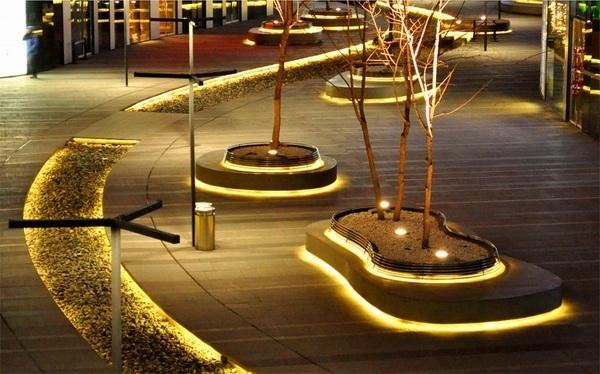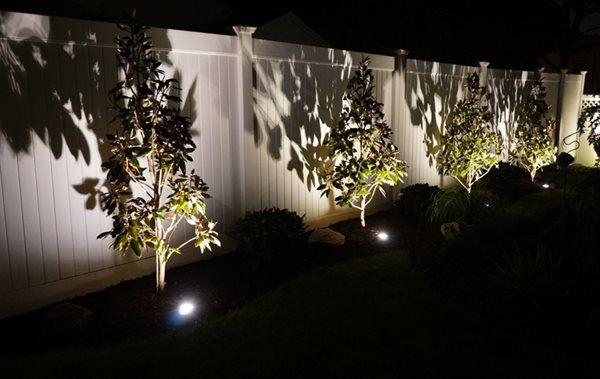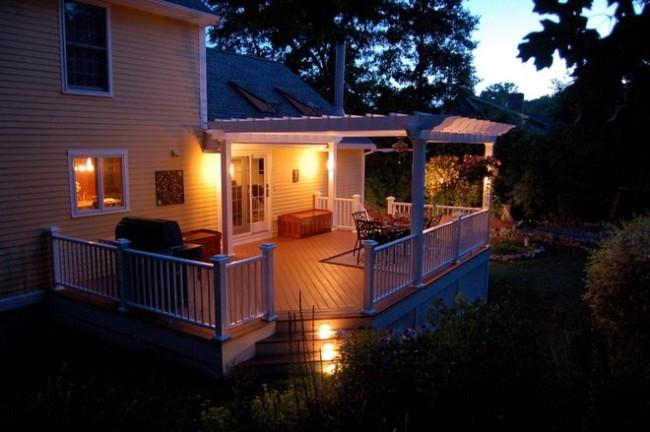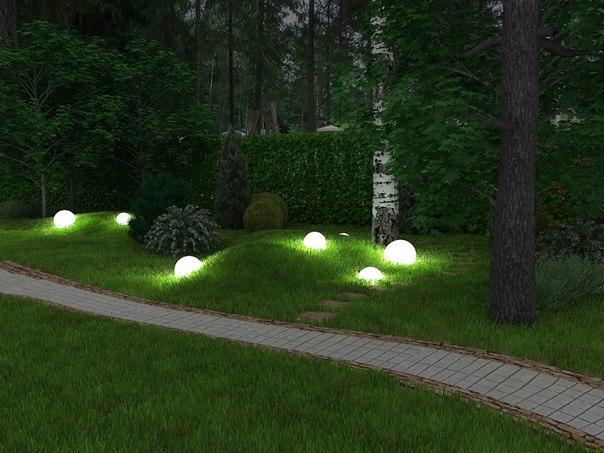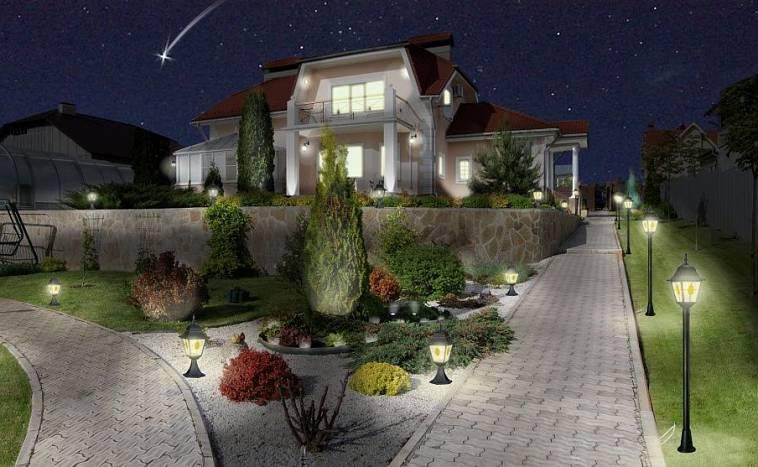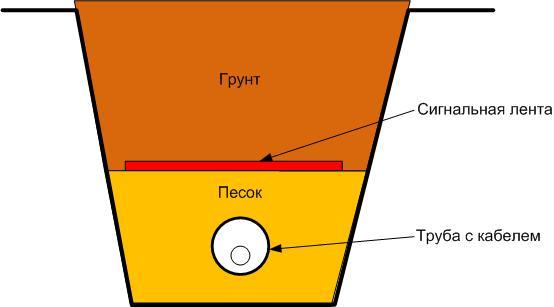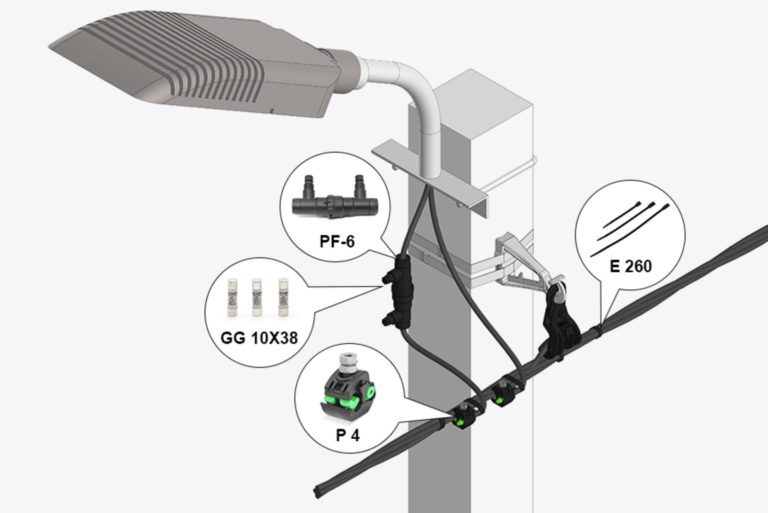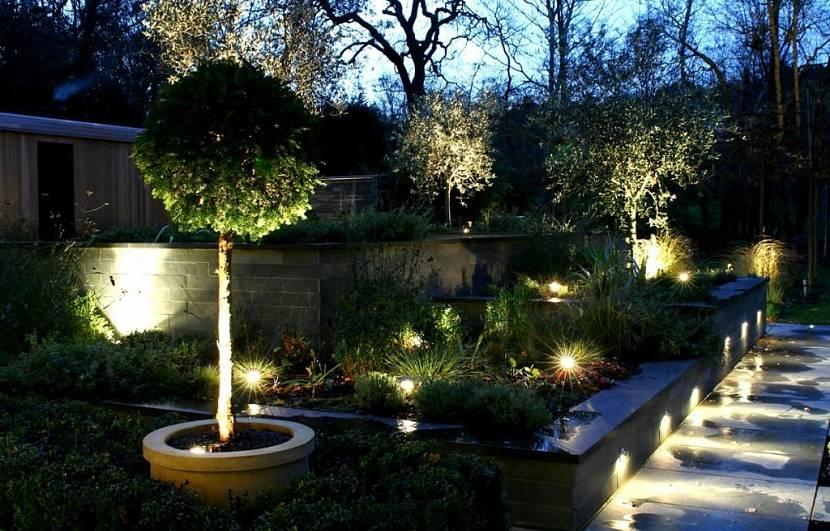Using lighting in landscape design
Landscape lighting is able to decorate the house or plot. Additionally, it can perform security functions. To arrange the lighting in your dacha, you need to understand what elements can be illuminated, what lighting options exist, and how to choose fixtures.
The use of lighting in landscape design
Landscape lighting is necessary not only for design, but also for convenience. Fixtures are placed along paths, at the entrance to the premises, in the garden, it allows not to stumble on a rock or other obstacle. Lighting is important in the presence of plants, which in total darkness is easy to crush.
Lights are needed to protect a private property. Choosing between a lighted and dark area, a thief is more likely to get into the latter. Together with video surveillance cameras, lamps become the main elements of security.
What to illuminate on garden plots
Just randomly placing light sources is unlikely to create a good composition. You need to determine which elements need to be backlit:
- Contour highlighting. Lamps are capable of marking the "boundaries" garden paths, flowerbeds, small structures. For this purpose, LED strip is usually used, it costs little, does not consume much electricity and is easy to install. You can also use special lamps powered by solar energy.Highlighting flowerbeds with LED tape.
- Pedestrian walkway. Even a neatly paved walkway becomes dangerous in the dark. The problem can be solved either by spot models embedded in the path itself, or by the streetlights that run along it.
- Trees. A tree can be backlit from below and become a focal point in a garden or patio. Another interesting solution is to highlight a group of trees and create a recreational area on their basis.
- Fence. With the help of light you can highlight the whole plot. In this case, either a flood or a scheme with small, fence-oriented spotlights, which are installed along the contour of the area at a certain distance from each other, will do.Highlighting the fence and trees near it.
- Decorative ponds and pools. Very important not only for decoration, but also for safety. It is better to use lights with different modes and filters. It is also important that they have a high degree moisture protection ..Just a few lights completely change the look of the pool bowl.
- Veranda. For many people this is a favorite place to relax in warm weather. Lighting can be conventional - a lamp on the ceiling, or you can experiment, for example - spot lights on the fence, columns, other elements.Side lighting on a small porch.
Types of landscape lighting
Landscape garden lighting can vary in terms of lighting elements, types of fixtures, area, power consumption, and other characteristics. The main element of the classification is functionality.
What options are available depending on the function
According to functionality, there are such types of landscape lighting:
- General. Necessary for lighting the area of the site. Performed with the help of poles, wall lamps, light sources installed on the fence. With quality general lighting can be convenient even to perform any work in the evening.
- Decorative. Not so much functional as a creative type of arrangement. With the help of special posts, diode ribbons, other uncomplicated sources emphasize individual elements on the territory. Christmas lights also belong to the decorative lighting.Decorative highlighting of the site.
- Technical. It is necessary for convenience and safety. Technical lighting includes lights near garage entrances, outbuildings, greenhouses, vegetable gardens, wells. It should use high quality fixtures with the ability to adjust.
- Security. The better illuminated the site - the less likely it is that thieves will appear. Light should cover literally every meter of the territory, so that no dark corners are left. Good lighting will keep not only people with evil intent, but also wild animals.Security lighting must provide the right level of security for the facility.
- Marking. Used to indicate certain elements. You can illuminate benches, steps, gazebo entrances, street faucets, summer showers and anything else that needs to be marked.Marking the steps.
In addition to site work, landscape lighting includes home décor. Horizontal lighting with garlands, ribbons, and built-in lamps is used to emphasize architectural forms.
In addition, it is possible to install small spotlights and lanterns, the light from which will go on the walls of the house. In this way you can strengthen the security functions.
Features of landscape lighting plants
There are several ways to arrange the lighting of plants, there are single-level and multilevel schemes. To create different effects, both bright bulbs and models with subdued light are used.
The owner of the site himself arranges everything the way he likes, but there are some recommendationsThey are based on the shape and size of greenery.
For example, for a large tree will need a lot of points of light, and for small plants may be enough for a single bulb. For tall plants, spotlighting is used, it is is installed at a distance of several meters from the trunk.
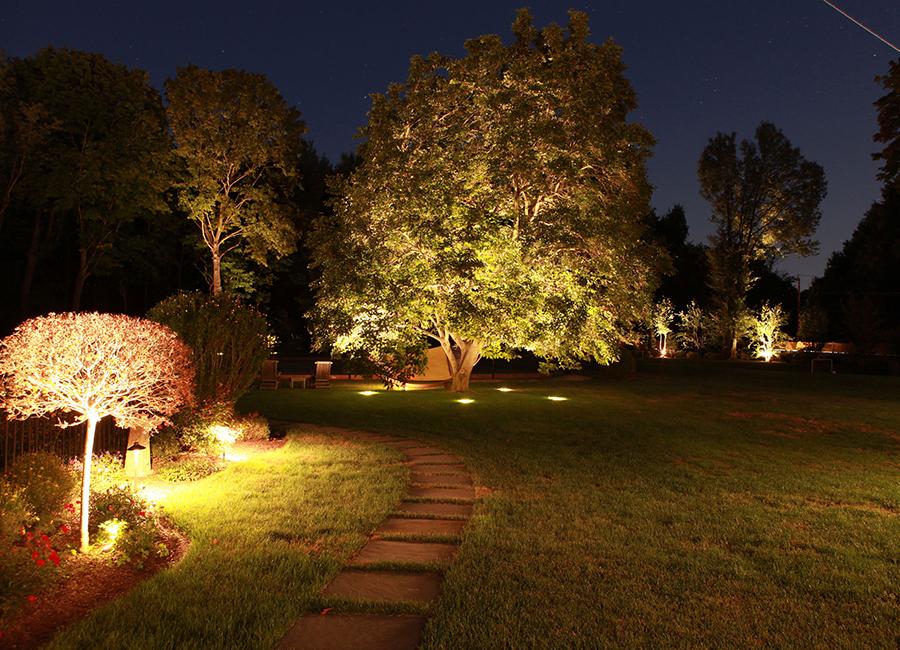
The height of the tree can also affect the location of the lamps. So, on a tall plant, it is possible to hang a downward pointing lampIt will act as an artificial moon. But it is better to use the scheme with a suspended lamp on a single tree. When installed under or behind the plant will illuminate the silhouette, will be clearly visible contours of the tree, its shape. It is possible to decorate plantings in winter time in an interesting way. When there are no more leaves and the branches are bare, you can hang them with colorful garlands.
It will not be superfluous to emphasize the lush trees and bushes. It is advised to put the spotlights at such an angle that there is no bright glare on the leaves. This can be achieved by directing the light stream to the trunk of the tree.
The nuances of selecting lighting fixtures
The variety of models for the dacha site can be confusing, so it is worth studying in advance the main points that should be focused on when choosing:
- Purpose. Only street lights will be suitable for the street. Yes, they are more expensive than indoor models, but they can work in all temperatures and are impervious to moisture and dust. Quality luminaires must meet IP65 or higher standards.Outdoor luminaires should be water-resistant.
- Voltage. If it is possible to install a step-down transformer, you can buy 12 volt light sources. Such lighting will be safer, and the laying of cables can be done in a shallow depth. But such a transformer is expensive and takes up space, without it you will have to use lights for 220 volts.
- Type of lamp. Incandescent models consume a lot of energy, while creating a "warm" light. If this is what you need, you can take them, if not - it is better to put halogen or LED bulbs.
- Color temperature. A special characteristic that determines the shade of light, measured in Kelvin. So, lamps up to 3300 K will produce a warm white, variants up to 5000 K will produce a neutral, and above 5000 K a cool white.The higher the heating temperature of the metal, the whiter the light.
- Functionality. Select lights should be chosen with the location where they will be installed, what functions they will perform. To illuminate the entire yard, you will need a high-powered lamp sitting high, and for plants, fences and small structures, you will need "floor-mounted" lamps of medium power. Weak lights will be needed for marking steps and paths, because their main task is to show that they are there, not to illuminate the area.It is better to use lights of approximately the same color temperature.
In addition to the technical characteristics, you should pay attention to the design. After all, only at night the main function of the lamp is lighting, and during the day it becomes part of the decor. Therefore, it is better to use not "bare" light bulbs, but models with beautiful plafonds.

Mounting landscape lights
The simplest option is to have solar-powered solar-powered or with batteries. They usually have a sharp end so they can be inserted into the ground. LED strips won't be much of a problem either. It comes complete with a power supply and is also equipped with adhesive tape so that it can be fixed to different surfaces.

The situation is more complicated when connecting a lighting system of several points or when setting up a full lantern of floor lamp or wall type.
The video will tell you about the 5 most popular methods of landscape lighting.
Preparing to install a floor lamp
This lighting option has a high power, it is able to illuminate the yard, parking lot, recreation area and other large areas. The work is done in this order:
- First you need to dig a hole for the foundation, the bottom is tamped with sand.
- Mounting the formwork with a tube for the power wire.Cutting of the trench after the work is finished.
- Pouring the concrete.
- After drying, in the previously installed tube, the connection cable is inserted.
- Everything is connected by means of terminal clamps.
- The lantern with the support is installed on the foundation, fixed with anchor bolts.

Mounting of wall models
Instructions:
- The power cable is led through the wall in the right place.
- Holes are drilled for the fastening elements.
- The back of the lantern is fastened with screws.
- Connect the power wires.
- Install the front of the lamp.

Scheme with recessed lamps
Such spotlights are installed in small recesses in the ground or concrete. In these recesses must pass power cables, they will be in the ground and must be in a protective box.
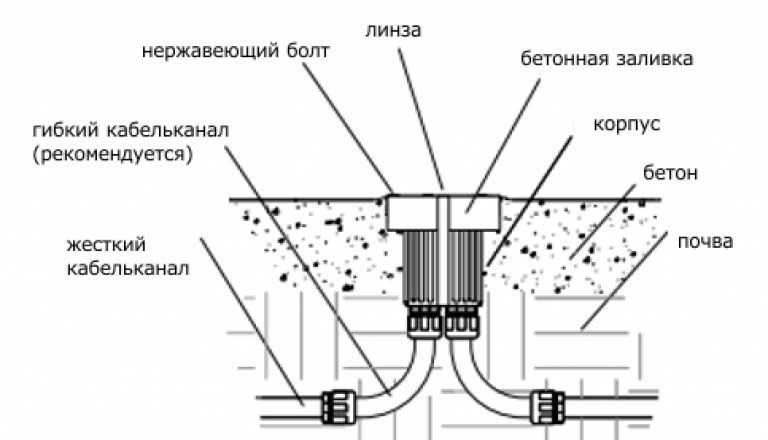
After the recessed lamp is installed and connected, the edges of this recess are concreted.
